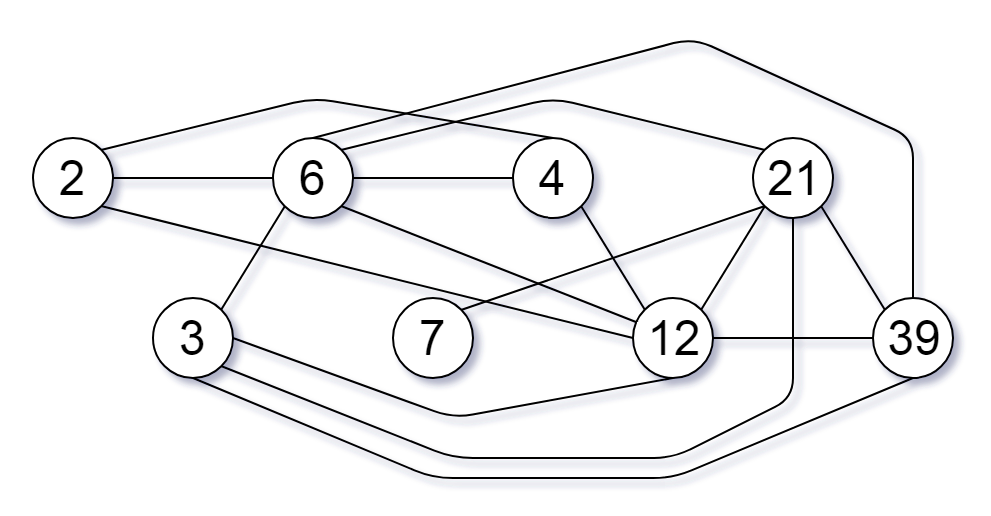★★★★★★★★★★★★★★★★★★★★★★★★★★★★★★★★★★★★★★★★
➤微信公众号:山青咏芝(shanqingyongzhi)
➤博客园地址:山青咏芝(https://www.cnblogs.com/strengthen/)
➤GitHub地址:https://github.com/strengthen/LeetCode
➤原文地址:https://www.cnblogs.com/strengthen/p/10053034.html
➤如果链接不是山青咏芝的博客园地址,则可能是爬取作者的文章。
➤原文已修改更新!强烈建议点击原文地址阅读!支持作者!支持原创!
★★★★★★★★★★★★★★★★★★★★★★★★★★★★★★★★★★★★★★★★
Given a non-empty array of unique positive integers A, consider the following graph:
- There are
A.lengthnodes, labelledA[0]toA[A.length - 1]; - There is an edge between
A[i]andA[j]if and only ifA[i]andA[j]share a common factor greater than 1.
Return the size of the largest connected component in the graph.
Example 1:
Input: [4,6,15,35]
Output: 4

Example 2:
Input: [20,50,9,63]
Output: 2

Example 3:
Input: [2,3,6,7,4,12,21,39]
Output: 8

Note:
1 <= A.length <= 200001 <= A[i] <= 100000
给定一个由不同正整数的组成的非空数组 A,考虑下面的图:
- 有
A.length个节点,按从A[0]到A[A.length - 1]标记; - 只有当
A[i]和A[j]共用一个大于 1 的公因数时,A[i]和A[j]之间才有一条边。
返回图中最大连通组件的大小。
示例 1:
输入:[4,6,15,35] 输出:4


示例 2:
输入:[20,50,9,63] 输出:2

示例 3:
输入:[2,3,6,7,4,12,21,39] 输出:8

提示:
1 <= A.length <= 200001 <= A[i] <= 100000
2676 ms
1 class Solution { 2 func largestComponentSize(_ A: [Int]) -> Int { 3 var lpf:[Int] = enumLowestPrimeFactors(100001) 4 var ds:DJSet = DJSet(100001) 5 for v in A 6 { 7 ds.w[v] = 1 8 } 9 for v in A 10 { 11 var vv:Int = v 12 while(vv > 1) 13 { 14 ds.union(v, lpf[vv]) 15 vv /= lpf[vv] 16 } 17 } 18 var ret:Int = 0 19 for i in 1...100000 20 { 21 if ds.upper[i] < 0 22 { 23 ret = max(ret, ds.w[i]) 24 } 25 } 26 return ret 27 } 28 29 func enumLowestPrimeFactors(_ n:Int) -> [Int] 30 { 31 var tot:Int = 0 32 var lpf:[Int] = [Int](repeating:0,count:n + 1) 33 var u:Double = Double(n + 32) 34 var lu:Double = log(u) 35 let num:Int = Int(u / lu + u / lu / lu * 1.5) 36 var primes:[Int] = [Int](repeating:0,count:num) 37 for i in 2...n 38 { 39 lpf[i] = i 40 } 41 for p in 2...n 42 { 43 if lpf[p] == p 44 { 45 primes[tot] = p 46 tot += 1 47 } 48 var tmp:Int = 0 49 var i:Int = 0 50 while(i < tot && primes[i] <= lpf[p] && primes[i] * p <= n) 51 { 52 tmp = primes[i] * p 53 lpf[tmp] = primes[i] 54 i += 1 55 } 56 } 57 return lpf 58 } 59 } 60 public class DJSet 61 { 62 var upper:[Int] 63 var w:[Int] 64 65 init(_ n:Int) 66 { 67 upper = [Int](repeating:-1,count:n) 68 w = [Int](repeating:0,count:n) 69 } 70 71 func root(_ x:Int) -> Int 72 { 73 if(upper[x] < 0) 74 { 75 return x 76 } 77 else 78 { 79 upper[x] = root(upper[x]) 80 return upper[x] 81 } 82 } 83 84 func equiv(_ x:Int,_ y:Int) -> Bool 85 { 86 return root(x) == root(y) 87 } 88 89 func union(_ x:Int,_ y:Int) -> Bool 90 { 91 var x:Int = root(x) 92 var y:Int = root(y) 93 if x != y 94 { 95 if upper[y] < upper[x] 96 { 97 var d:Int = x 98 x = y 99 y = d 100 } 101 upper[x] += upper[y] 102 upper[y] = x 103 w[x] += w[y] 104 } 105 return x == y 106 } 107 108 func count() -> Int 109 { 110 var ct:Int = 0 111 for u in upper 112 { 113 if u < 0 114 { 115 ct += 1 116 } 117 } 118 return ct 119 } 120 }